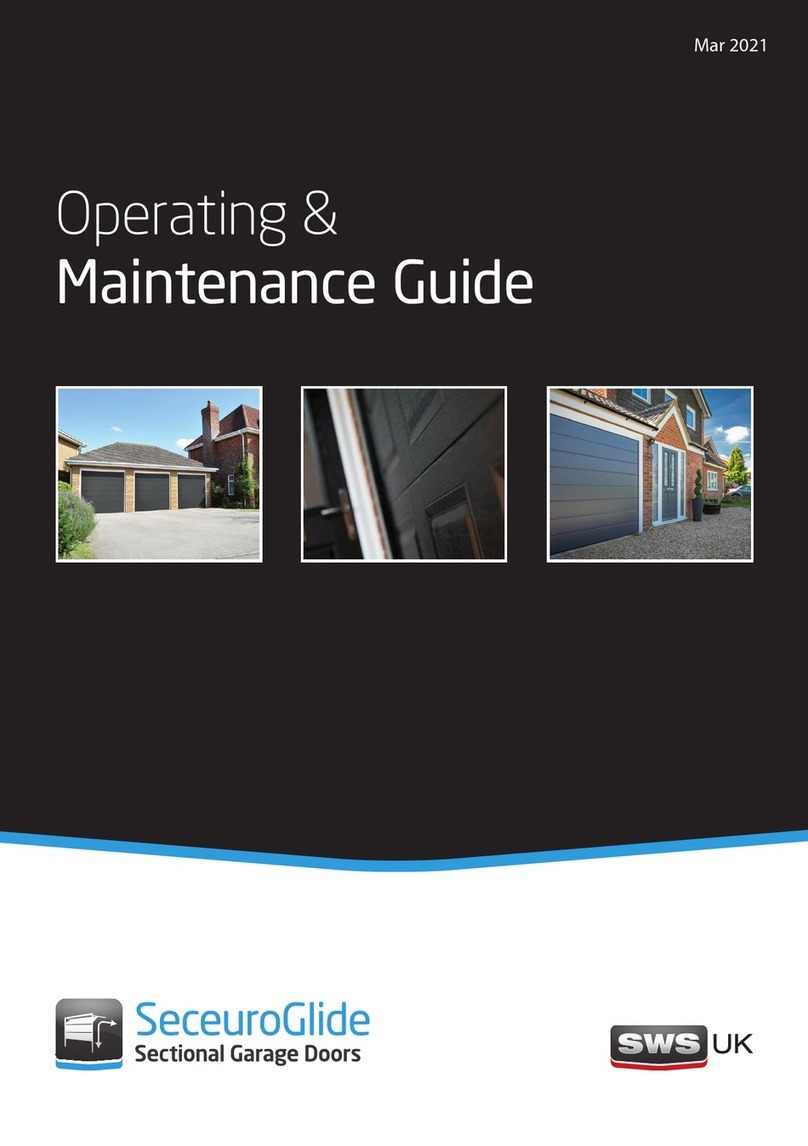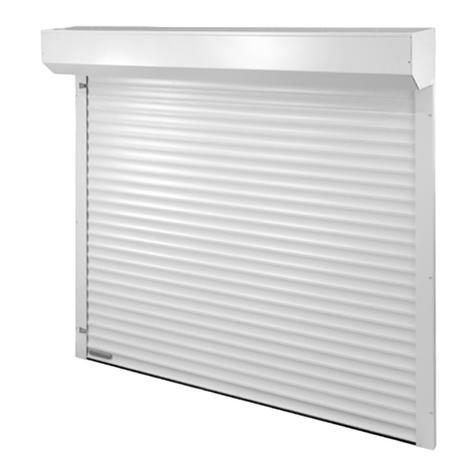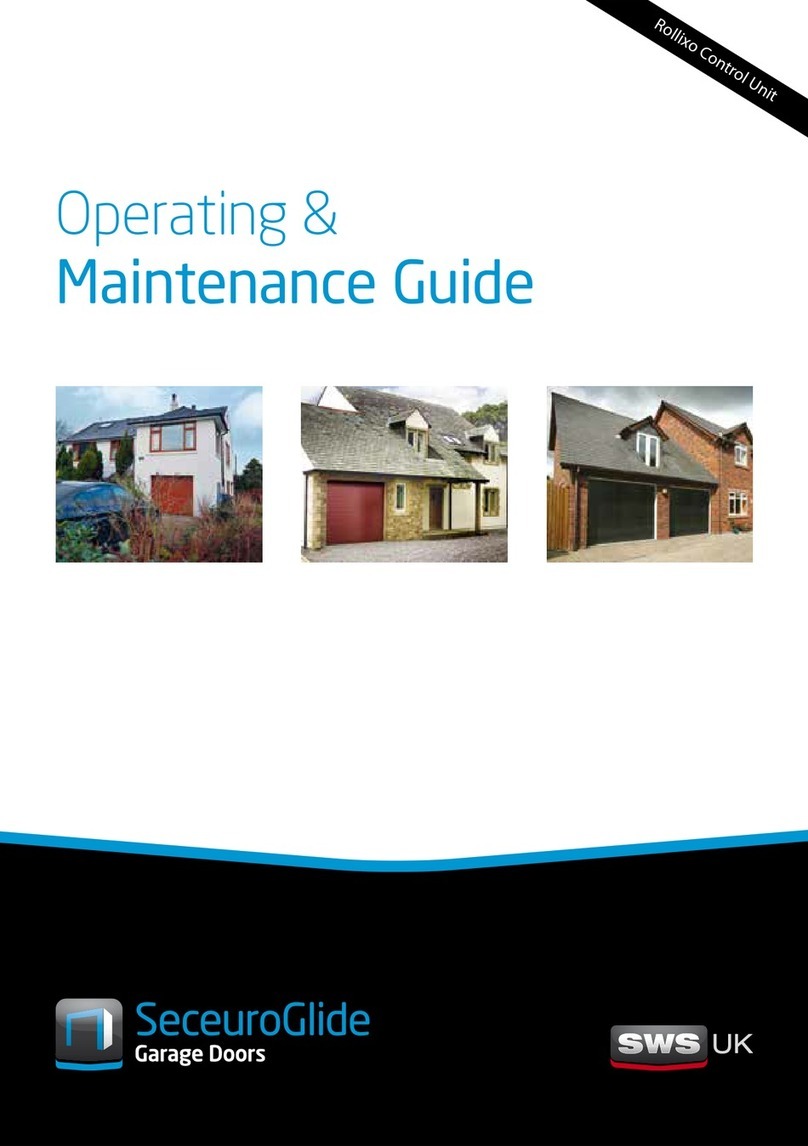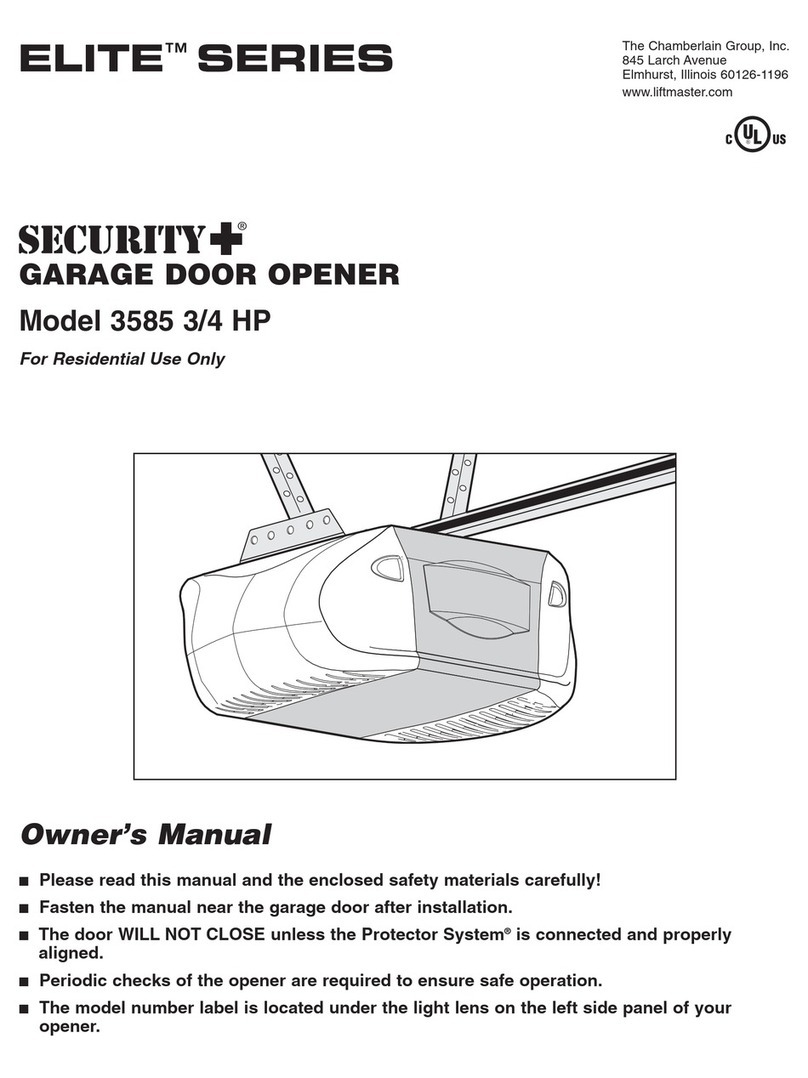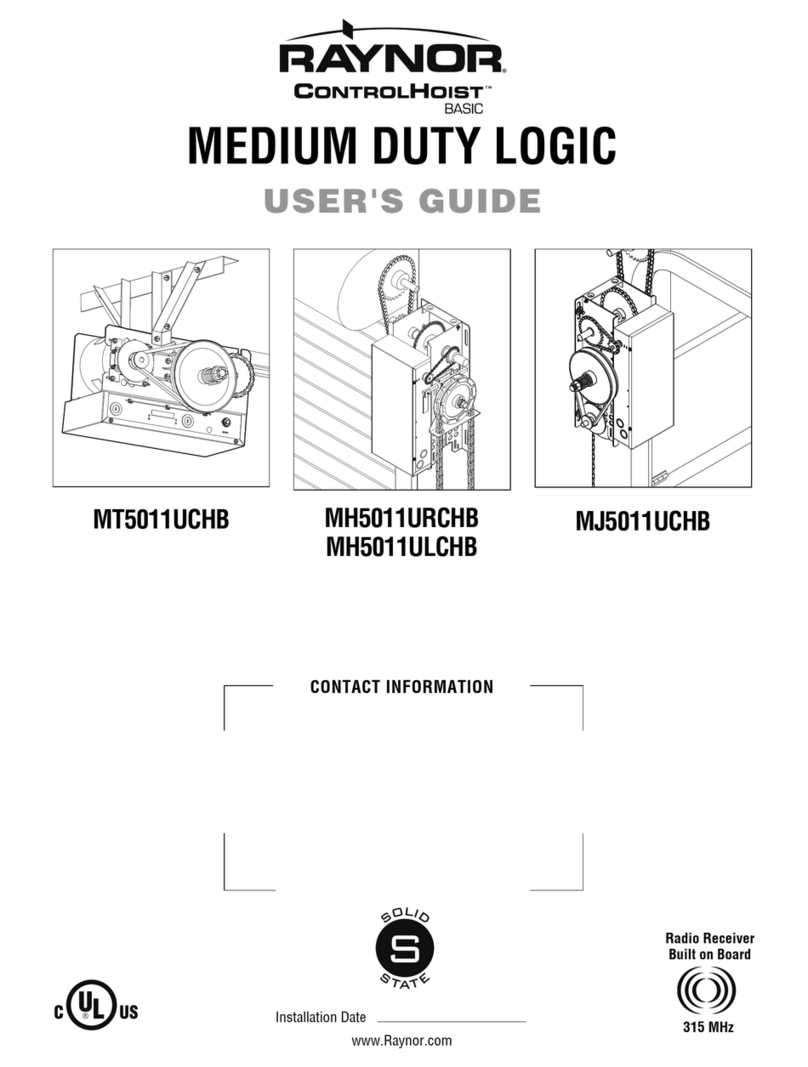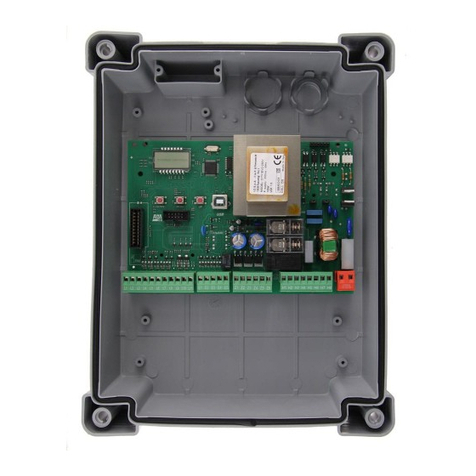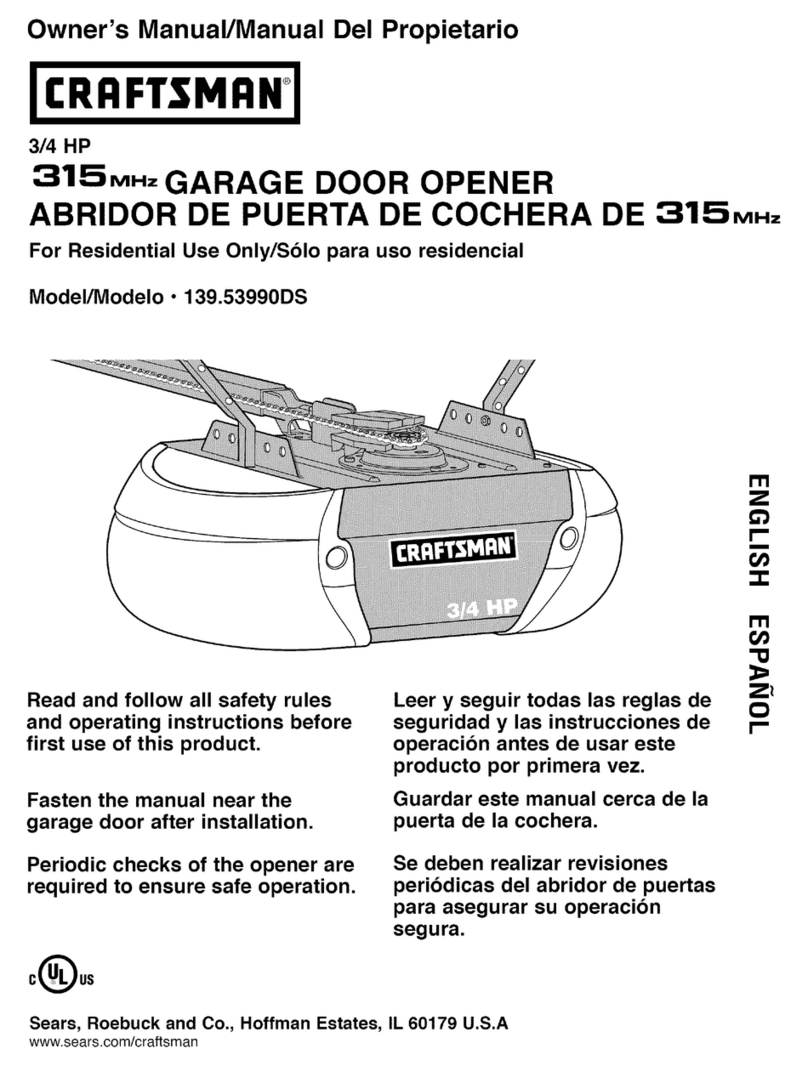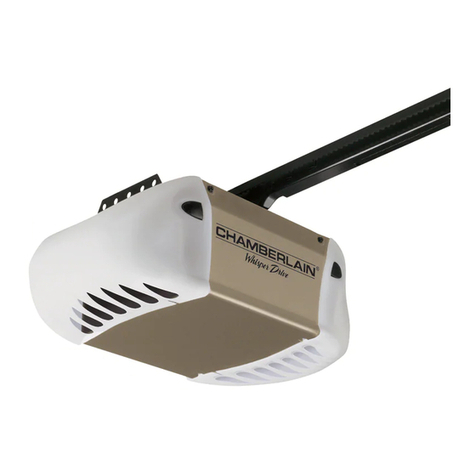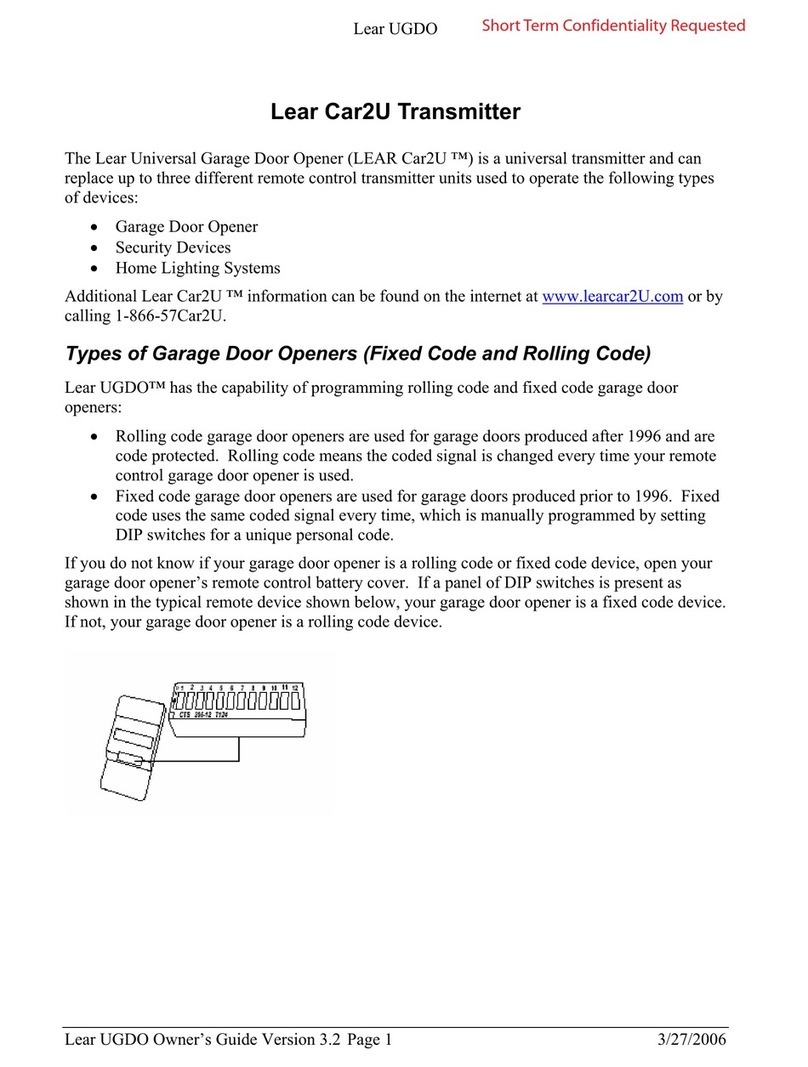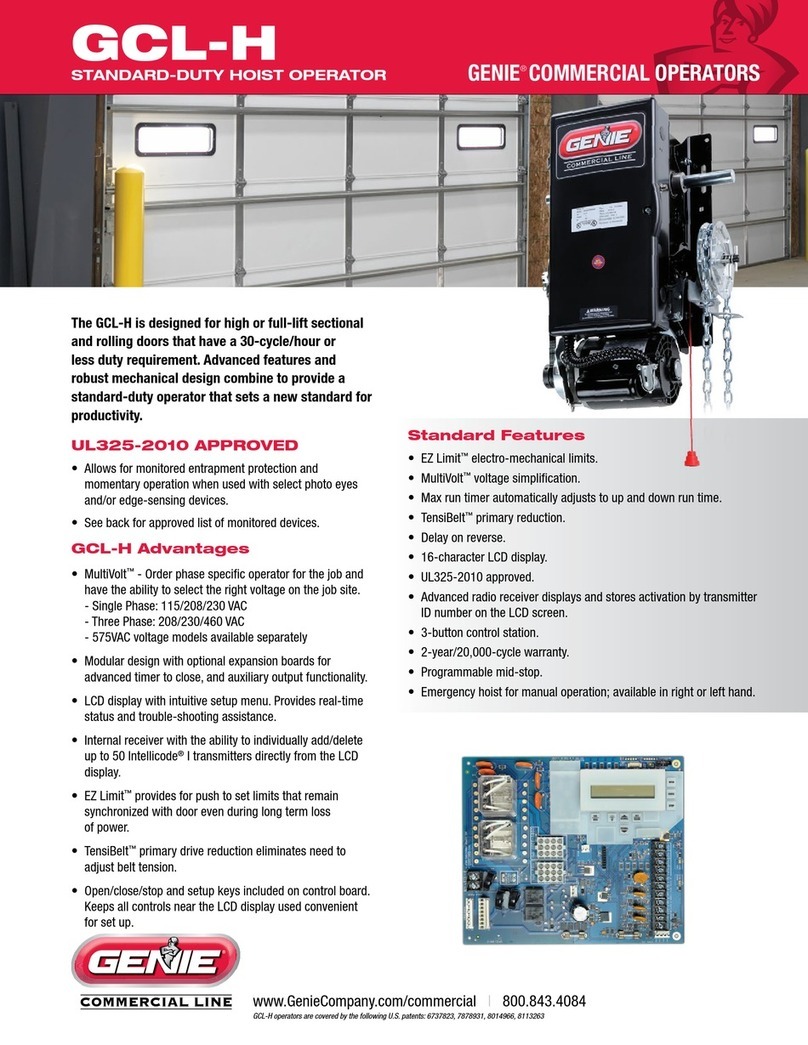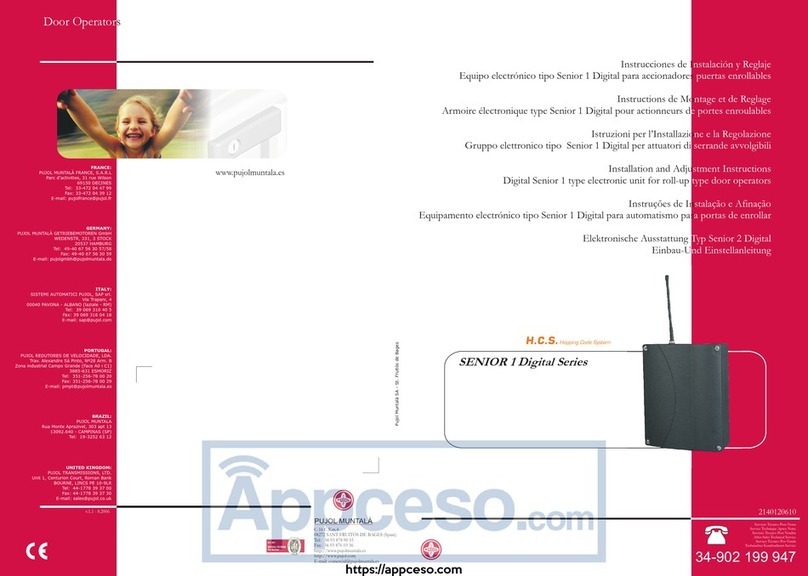SWS SeceuroGlide Manual User manual

1
Total Height
Ground Height
Headroom
Drive Through Height
Drive Through Width
Over Guide Width
Note: Due to ongoing development some of the information and procedures may not exactly correlate to the product received. If in
doubt, please ask your supplier.
Electric Roller Garage Door
Installation Instructions
ALWAYS CHECK ON DELIVERY THAT THE ORDER DETAILS ARE CORRECT AND THE
DOOR IS UNDAMAGED BEFORE REMOVING ANY EXISTING DOORS.
Check:
i) delivery note
ii) order sheet
iii) door dimensions/colour
iv) opening dimensions \clearances
v) components
vi) Check for any damage to the guide rails
or the outside roll of the curtain
Do not proceed further with the
installation unless you are sure that
the door is the correct size, and all
components are present.
Widths
Order Width = Over Guide Width
Drive Through Width = Over Guide Width less 150mm for 75mm guides
Drive Through Width = Over Guide Width less 180mm for 90mm guides
Curtain Width = Over Guide Width less 90mm
Axle Width = Over Guide Width less 90mm (without spring)
= Over Guide Width less 73mm (with spring)
Heights
Order Height = Guide Height
Total Height = Guide Height + End Plate
Headroom/End Plate
up to 2.5m Guide Height = 300mm
up to 3.5m Guide Height = 350mm
Drive Through Height = Guide Height less 55mm
1
April 2013 Issue 1 MK516BO
Sequence of Installation & Contents
1. Pre-installation and component check
2. Installation options and criteria for compliance with LPS 1175
3. Prepare the opening
4. Prepare the guide rails
5. Fit end plates, guides & axle (& optional fascia)
6. Fit emergency overrides
7. Curtain adjustment (reducing height/making repairs)
8.
Install the curtain in the guides, attach to axle & fit stops
9. Curtain locking & setting motor limit switches
10. Commissioning
11. Maintenance, repairing and dismantling instructions
1. PRE-INSTALLATION AND COMPONENT CHECK:
www.samsondoors.co.uk
0800 328 6250
www.samsondoors.co.uk
www.samsondoors.co.uk
0800 328 6250
www.samsondoors.co.uk

2
ELECTRIC ROLLER GARAGE DOOR COMPONENTS
1a OPTIONAL 90 DEGREE FASCIA
1b OPTIONAL 45 DEGREE LID
2 MOTOR (fitted into axle)
3 102mm ROUND AXLE
4 LOCKING COLLARS (fitted to axle 6 No. up to 2.5m, 8 No. up to 3.5m
10 No.over 3.5m)
5 DUMMY END or SPRING
6 6 x No. 8 x 3⁄8 PAN HEAD SCREWS * (for securing octagonal fixing plates
in mounting bracket, see component 7)
7 DUMMY END OCTAGONAL FIXING PLATE (secured to shaft by split
pin - see component 29)
8 MOTOR OCTAGONAL FIXING PLATE (bolted to motor)
9 ATTACHMENT/LOCKING ARM (1 No. L/H 1 No. R/H complete with
locking bolt and lock nut, 1 - 3 No. intermediate)
10 R/H END PLATE
11 L/H END PLATE
12 GUIDE ROLLER (fitted to end plates with star clinch lock washer)
13 MOUNTING BRACKET (fitted to end plates)
14 GUIDE RAILS
15 BRUSH INSERT (fitted to guides)
16 CURTAIN
17 TOP SLAT (fitted to door curtain)
18 POLYESTER WEBBING STRIP (fitted to curtain)
19 8 x 1/2 FLANGE HEAD SELF TAPPING SCREW (securing webbing to curtain)
20 BOTTOM SLAT (fitted to curtain)
21 RUBBER SEAL (fitted to bottom slat)
22 RIGID OVERRIDE EYE (inc. allan cap screw & washer) or DROP EYE
JOINT (if 350mm end plates are required) *
23 CRANK HANDLE
24 STOP BLOCKS * (for fitting to bottom slat)
25 2 No. M6 NUTS (inserted in bottom slat for securing stop blocks)
26 2 No. M6 X 30 BOLTS * (for fixing stop blocks)
27 7 No. 4.8mm x 9.3mm x 12mm POP RIVETS
* (for securing axle collars)
27b 3 No. 8 x 1/2 FLANGE HEAD SELF TAPPING SCREWS
* (for securing webbing strips to curtain)
28 CRANK HANDLE CLIP *
29 1 x 60mm SPLIT PIN (to secure the octagonal fixing plate to the dummy
end/ spring shaft)
30 3 x CABLE TIES * (for securing motor cable to end plate)
* Supplied in accessory pack.
Recommended Fixings (not supplied)
12 x 1” Self Tapping Screws for Steel
12 x 2 1⁄2” Countersunk Screws for Masonry and Wood
1. Axle, guides, crank handles, facias (if the door is 3.5m wide or
greater) and if applicable the external override kit will be wrapped
together in one bubble wrapped parcel and strapped together.
2. The curtain and aluminium facias (if the door is less than 3.5m
wide) will be packed together.
3. A separate accessories box is packed with the installation and
end user instructions, the two end plates, the attachment /locking
arms, the accessory pack and a box containing the electrical items.
PACKAGING METHOD:
2
4
3
8
11
13
14
9
18
19
15
20
23
24
25
21
12
10
7
5
6
28
29
27
26
30
16
17
22
1b
22
1a
www.samsondoors.co.uk
0800 328 6250
www.samsondoors.co.uk
www.samsondoors.co.uk
0800 328 6250
www.samsondoors.co.uk

Internal installation only
The garage door must be installed
internally. If all of the end plate is not
fitted above the openng then a 90°
facia must be fitted to the door.
Face fit
If the guide rails are face fitted they must not protrude into the
opening and they must be 90mm.
Reveal fit
If the guide rails are reveal fitted they must be 90mm guide rails
complete with steel reinforcement plates to protect the base of the
guide rails.
Minimum number of fixings per guide rail
Proximity of holes to the end of the guide rails
The first and last holes at the ends of the guide rails must be drilled
120mm from the ends of the guide rails.
Minimum number of fixings per end plate
$OOWKUHH¿[LQJKROHVLQHDFKHQGSODWHPXVWEHXVHG
Minimum required fasteners
Brick / Blockwork
No. 12x2" screw with suitable plastic plug
Timber frame
No. 12x2" screw
Steel fixing (any of the following)
a. 5 x 25mmTec screws
b. No. 10x1" Pozi Pan head screws
c. M8 x10mm hex head or dome head bolts tapped in to the steel
work (minimum 5mm thick steel)
d. M8 bolts and nuts
All fixing heads must be spoiled for compliance with LPS
1175.
All switches, key switches and remote control equipment
must be installed on the inside of the garage for compliance
with LPS 1175
The label supplied, stating the manufacturer, the product,
the security rating and the certificate number must be
attached to the door.
Please note: The validity of the LPCB certification is contingent
External installation
The door can be installed externally if
compliance with LPS 1175 is not required.
Please note the remote control receiver
unit and the bottom slat safety edge
transmitter must be installed internally
and not exposed to the elements
Face fit
75mm guide rails can be used if compliance with LPS 1175 is not
required.
Reveal fit
If compliance with LPS 1175 is not required 75mm guide rails can
be fitted within the reveal.
Combination of face and reveal fit
In this situation one guide rail is reveal fitted and the other guide
rail is face fitted.
Undersize face fit
In this situation the guide rails are face fitted but they will protrude
into the opening. This installation will not be compliant with LPS
1175.
90mm
75mm
90mm
90mm
75mm
75mm 90mm
3
2. INSTALLATION CRITERIA FOR COMPLIANCE WITH LPS 1175: ISSUE 7
ALTERNATIVE INSTALLATION OPTIONS (not compliant with LPS 1175)
Height of guide rails Minimum no. of xings required
less than or equal to 1000mm 3
1001mm to 1500mm 4
1501mm to 2500mm 5
2501mm to 3500mm 6
3500mm + 7
You must
use all three
You must
use all three
xing holes
75mm 90mm
www.samsondoors.co.uk
0800 328 6250
www.samsondoors.co.uk
www.samsondoors.co.uk
0800 328 6250
www.samsondoors.co.uk

4
Please note: The validity of the LPCB certification is contingent
upon the roller garage door being installed in accordance with the
requirements of LPS 1175 (see section 2 for further details).
If the guides require cutting down refer to the information at
the start of Section 1 and also section 6 for reducing the curtain
height. If face fixing where possible set the guide height at least
55mm above the structural opening height to maximise drive
through height.
i) position guides
ii) drill guide fixing holes 7mm pilot hole 13mm outer hole
(min 4) avoid mortar joints and edges of bricks etc.
LPS 1175 compliant doors
Doors which are compliant with LPS 1175 will be supplied with a
bottom slat anchor system prefitted to the bottom slat and guide
rails.
Once the guide rails have been fastened in place the bottom slat
anchor guide insert must be fastened to the floor as shown below.
Bottom Slat
Hang Down
55mm
Drive Through
Height
Guide/Door
Height
REVEAL FIX
INTERNAL
SIDE
7mm
13mm
75mm
4. PREPARE THE GUIDE RAILS:
FACE
DRILL
FACE FIX
13mm
7mm
75mm
INTERNAL
SIDE
N.B. 90mm guides are handed
90mm
Check:
i) structure is sound/even & can carry the weight of the door
(curtain weight is approximately 5kg/m2 and allow an extra
15kg for the guides, end plates and axle assembly).
ii) no obstacles in fitting footprint e.g. no sharp objects, pipes,
cables, bumps etc. sticking out from the pillars, lintel or
header to twist the guides, distort the fascia or catch on the
curtain
iii) floor is flat/level
If necessary install a sub-frame to ensure secure, flush and level
fixing. (Recommended minimum 70 X 70 PAR)
3. PREPARE THE OPENING:
5. FIT END PLATES, AXLE ASSEMBLY, GUIDES (& OPTIONAL FASCIA):
N.B. When fitting doors with 300mm end plates and the guide
height is more than 2300mm it is important that you check that
the lintel does not bow inwards or have any projections that may
catch on the curtain. If in doubt pack the guides and end plates out
by at least 10mm.
i) slot end plates into guides (and fix optional fascia if supplied) -
see drawing A
If using 90mm guides make sure the back face of the end
plate is in line with the back of the guide.
3 rivets should be used to fasten the fascia to each end plate.
Doors compliant with LPS1175 will be supplied with penny
washers which the rivets must be fastened through.
ii) position guides, end plates (and optional fascia) against/in
opening
iii) hold or prop securely in position
iv) drill fixing holes (minimum of 4 in guides and 2 in each end
plate if not LPS 1175 compliant)
v) fix guides/end plates with minimum No. 12 x 21»´
countersunk screws (and plugs) to masonry/timber or 12 x
´VHOIWDSSLQJVFUHZVWRVWHHO)L[IDVFLDHYHU\PHWUHZLWK
PLQLPXP[´VFUHZV3HQQ\ZDVKHUVPXVWEHXVHGWR
spread fixing load on fascia. If there is nothing to fix to, 50 x
20 box section should be ordered to reinforce the fascia and
prevent deflection which may damage the curtain. Drill and
pop rivet from inside the fascia ensuring that the rivet leaves a
smooth surface.
vi) ease open top of guides – see drawing C
Before proceeding any further check:
a) back faces of guides and end plates are flush and untwisted – see drawing B
b) that the distance between the outside edges of the guides is 90mm more than the curtain
width
c) ensure that the distance between the outer edges of the end plates is
equal to the stated overall width of the door.
Drawing B
Drawing A
The dummy end octagonal
fixing plate is supplied in the
accessory box. The plate must
be fitted to the appropriate
end plate (not the motor side)
before installation of the axle.
Drawing C
REVEAL
DRILL
FIXED TO FLOOR WITH
MINIMUM OF 1 1/2 INCH No.12
GUIDE INSERT FIXED TO GUIDE
GUIDE RAIL
High winds and high temperatures can cause increased deflection of the door. It is the installer's responsibility to ensure that the door is
packed off the wall sufficiently to allow for door movement during these extreme weather conditions.
www.samsondoors.co.uk
0800 328 6250
www.samsondoors.co.uk
www.samsondoors.co.uk
0800 328 6250
www.samsondoors.co.uk

5
vii) The dummy end octagonal fixing plate is supplied in the
accessory box. The plate must be fitted to the appropriate end
plate (not the motor side) before installation of the axle.
Offer up the axle assembly to the end plates inserting the
octagonal plate attached to the motor into the end plate
mounting bracket and the dummy end/spring shaft into the U
cup on the dummy end octagonal fixing plate. Secure the shaft
using the 60mm split pin provided. Make sure the motor and
override hole are correctly orientated and the limit switches
are accessible from below - see motor drawings 1 to 3 -
Section 6.
viii) secure axle by inserting the No. 8 x 3»SDQKHDGVFUHZV
supplied into the holes in the mounting brackets (give the axle
a tug to make sure it is securely retained) – see bubble detail
drawing A
Lock dummy end shaft securely in place, hard up against the
dummy end, with clip provided so as to prevent the axle from
moving from its correct position.
Check:
a) guides are vertical / parallel / same height and axle is
level – see drawing D
b) collars are the correct way around – see drawing F
N.B. In the event that the screw does not hold, drill a new pilot
hole through the mounting bracket and octagonal fixing plate and
try again.
For safety reasons it is essential that the fixing plate is secured
with three fixings.
ix) secure motor POWER LEAD with CABLE TIES so that it is tight
against THE end plate – see drawing E
Alternatively you may drill a hole in the end plate to pass the
cable through in order to keep it clear of the locking bolt.
N.B. This may not be possible with tight reveal fixes.
You must ensure that you allow for a drip loop in the motor cable
to prevent water from running down the cable and into the motor.
Spare cable ties can be attached to the motor cable to act as drip
loop to prevent water entering the motor.
If an anti-fall back spring has been supplied fitted in the axle you
must now tension the spring as follows:
1) Connect the motor to either a test lead or the remote control.
2) Remove and retain the limit cover cap from the motor. Fully
press in the limit switches on the motor. Using either the test
lead or remote control rotate the axle in the close direction
(see drawing G and label on axle).
3) The number of turns required will be clearly stated on a label.
4) When complete the axle will be fully tensioned and will be
ready for installation and attachment of the curtain in the fully
closed position.
5) Replace the limit cover cap.
Drawing D
Drawing F
Drawing E
Drawing G
6.
FITTING EMERGENCY OVERRIDES:
1
Left Hand viewed
from centre of door
23
Right Hand viewed
from centre of door
POSSIBLE OVERRIDE EXIT OPTIONS
N.B. We recommend override exits 1 or 2 shown above as
option 3 will be more difficult to operate
Axle assembly
must be level
5
Dummy end octagonal
fixing plate must be this
way up
www.samsondoors.co.uk
0800 328 6250
www.samsondoors.co.uk
www.samsondoors.co.uk
0800 328 6250
www.samsondoors.co.uk

6
A) Standard Manual Override
If this door has end plates that are not fitted above the opening
and it is compliant with LPS1175 then a plastic tube must be fitted
over the rigid eye before it is inserted into the motor and secured
in place.
i) insert override eye through hole in motor adjacent to limit
adjusters
ii) insert and tighten the holding screw and washer from above
iii) hook crank handle to eye
iv) secure clear of shutter with crank handle clip
Standard
Manual Override
B) Optional external low level override
Detailed installation instructions are supplied in the low level over-
ride kit.
The external low level override is not compliant with LPS 1175, a
battery backup must be ordered when required.
7. CURTAIN ADJUSTMENT (REDUCING HEIGHT/MAKING REPAIRS)
The curtain needs to be the correct height for the door to lock
properly (if too tall remove slat(s) - If too short notify supplier).
The optimum curtain height finishes midway up the end plate to
ensure the locking mechanism engages.
Check you have the correct number of slats in the curtain for the
guide height (particularly if you have shortened the guide height)
and adjust the curtain accordingly.
The number of slats shown is the number of foam filled slats
only. The curtain height shown includes the bottom slat and the
extruded top slat.
Curtain height =
Curtain slats
+ Extruded top slat
+ Bottom slat
i) Roll out the curtain on a flat and protected surface, such as
bubble wrap and/or cardboard packaging in which the curtain
was delivered.
ii) Unscrew webbing from every slat which needs to be removed
or replaced, gently lifting the webbing away from the surface
of the slat.
iii) Slide out damaged slats and replace with new slats. Press
down webbing and screw to the new slat.
iv) If the number of slats has been reduced, trim the webbing
accordingly and carefully melt the cut ends to prevent fraying.
REMOVE SCREW
LIFT WEBBING
REMOVE SCREW
SLIDE BACK
NEW SLATS
SLIDE OUT
DAMAGED
SLATS
PRESS
DOWN
WEBBING
RE-SCREW
8 x 1/2 FLANGE HEAD SELF-
TAPPING SCREW
21 1769 300
22 1847 300
23 1926 300
24 2004 300
25 2083 300
26 2161 300
27 2240 300
SLATS CURTAIN HEIGHT END
PLATE
28 2318 300
29 2397 300
30 2475 300
31 2554 300
32 2632 300
33 2711 350
34 2789 350
CURTAIN END
SLATS HEIGHT PLATE
35 2686 350
36 2946 350
37 3025 350
38 3103 350
39 3182 350
40 3260 350
SLATS CURTAIN HEIGHT END
PLATE
41 3339 350
42 3417 350
43 3496 350
44 3574 350
45 3653 350
46 3731 350
CURTAIN END
SLATS HEIGHT PLATE
www.samsondoors.co.uk
0800 328 6250
www.samsondoors.co.uk
www.samsondoors.co.uk
0800 328 6250
www.samsondoors.co.uk

77
8. INSTALL THE CURTAIN IN THE GUIDES, ATTACH TO AXLE & FIT STOPS
i) Check that there are at least 3 pairs of collars on the axle and
that they are facing the correct direction – see drawing D.
The outside collars must be right at the ends of the axle and
the third pair in the middle.
If 4 or more pairs are fitted then two of the additional pairs
need to be fitted approx. 700mm in from the outside pair.
(N.B. the outside collars are held in place by the motor collar
at one end and the dummy end at the other. Intermediate
pairs will have one collar pre-positioned at the factory with a
securing rivet already in place).
Before loading the curtain into the guide rails ensure that the
locking blocks are located at the top of the end plate.
Remove attachment arms, wrap bubble wrap around the
axle to protect the curtain and continue with remaining
instructions.
ii) Lift coiled curtain up level with axle and feed bottom of curtain
into guide
iii) Slowly unroll curtain and gently lower onto a tool box or block
N.B. Do not allow the curtain to free fall over the axle as this will
result in damage to the curtain
iv) slide the locking/attachment arms on to the top slat
For the above see drawing A
v) position unattached end of locking/attachment arm so that the
fixing bolt line up with locating holes in the two collars (rotate
axle with override if necessary) and slide collars together
making sure pre-positioned collar is tight against rivet – see
drawings B & C
vi) fix ‘loose’ collars in position by placing a 4.8mm x 9.3mm
x 12mm pop rivets tight up against the outside edge of the
collar in the rounded cut-out in the axle. There is no need to
drill a hole – see drawing D
N.B. Make sure rivets are secure
vii) use override to raise door sufficiently to remove toolbox/block.
Leave door in partially open position
viii) secure stops to captive nuts in bottom slat with bolts provided
– see drawing E
N.B. It is essential to fit stops for health and safety reasons
Drawing D
(view from outside)
v
After a door has been installed, during normal operation, the
door will settle causing the fully open and fully closed positions to
move slightly from the original positions.
Drawing A
(view from inside)
Drawing C
(view from outside)
Drawing D
(view from outside)
STOP
M6 BOLT
Drawing E
(view from inside)
Drawing B
(view from outside)
LPS 1175 Compliance
All doors which have been ordered to comply with LPS 1175 will
have been supplied with a silver label stating the product name, the
manufacturer and the security level the door achieved.
is label must be attached to the guide rail for the door to be
compliant.
Locking Block
www.samsondoors.co.uk
0800 328 6250
www.samsondoors.co.uk
www.samsondoors.co.uk
0800 328 6250
www.samsondoors.co.uk

8 8
9. CURTAIN LOCKING & SETTING MOTOR LIMIT SWITCHES
Before you operate the door electrically you may want to
operate the door slowly using the manual override provided
to ensure that the door will not catch on any protrusions as
it travels up and down.
Your garage door is manufactured with the curtain height to suit
the length of guide supplied. The door will not lock down properly
if the curtain is either too tall or too short. (If too tall remove
slat(s) – if too short notify supplier). For best results the top of
the curtain should be as near as possible in line with the centre of
the axle.
Both limits require setting along with a final adjustment of the
locking mechanism.
We recommend the use of the manual override to set the limits
and to make final adjustments as you will have far greater control
of the door as it travels up and down. To set the limits remove the
cap covering the white/yellow limit switches, fully press in both
switches (they will lock into position) and then proceed as follows.
N.B. Incorrect setting of the limits
risks damage to the motor and
curtain.
Closed / down limit setting and locking section
adjustment:
The locking block position must be checked before proceeding –
i) wind door down with override handle until the curtain is
touching the floor but stop just before the top of the curtain
closes against the ‘shut’ face.
ii) Lower the locking blocks so that they are positioned
approximately 2mm above the blocks fitted to the curtain
when the curtain is in the fully closed position. Ensure that
both screws in each block are tightened so that the block will
not be lifted.
iii) Continue to wind door down until the curtain is tight against
‘shut face’ but not over tight (the extrusions will deform if you
force the top slat too hard into the lintel)
iv) set the motor closed/down limit by releasing limit switch.
Open/Top Limit Setting:
i) Wind the door with the hand crank to open / up position and
stop (50mm of curtain should still
be in guide. Stops should be min.
10mm below guide rollers)
ii) press and release the open/up limit
switch
N.B. Always replace the yellow limit
switch cover cap once limits are set.
i
Left Hand Motor
Fully press in limit switch to activate. Press and release switch when door has been set to
stop in correct position. The yellow limit switch activates the OPEN/UP limit. The white
limit switch activates the CLOSE/DOWN limit.
C
l d / d li it tti d l ki ti
Right Hand Motor
Fully press in limit switch to activate. Press and release switch when door has been set to
stop in correct position. The yellow limit switch activates the CLOSE/DOWN limit. The
white limit switch activates the OPEN/UP limit.
Open/up Close/down
C
l
ose
/d
ow
n
O
p
en
/
u
p
Fully press in
to set limits.
Release limit
when set
Drawing B
MIN 10mm
Roller
After a door has been installed, during normal operation, the the
door will settle causing the fully open and fully closed positions to
move slightly from the original positions.
N.B. To prevent damage to the
motor make sure the door is
stopped by reaching the limit
switch. Do not allow stops to
come into contact with guide
rollers.
Drawing A
8
www.samsondoors.co.uk
0800 328 6250
www.samsondoors.co.uk
www.samsondoors.co.uk
0800 328 6250
www.samsondoors.co.uk

INTERNAL FITTING
Fit optional 45 degree lid. A slot may have to be cut into the lid to
pass over the override eye.
FINAL CHECKS
i) remove any protective plastic coverings
ii) wipe curtain & guides with damp cloth
iii) touch-up any small scratches
iv) check all electrical & operating equipment is installed and
functioning correctly (especially the safety edge) and complete
CE marking label and paperwork
v) check direction handle needs winding to open door and fit
appropriate label supplied to crank handle.
vi) If the door is fitted externally apply a bead of silicone around
the box edge to prevent water ingress.
N.B. Check the front of the curtain to make sure that it is not
rubbing on the fascia etc.
The manual override will not function after the door is operated,
by remote control, until the power to the motor has ‘timed out’.
This will take a few moments to occur.
If you wish to demonstrate the manual override immediately after
opening the door press either the stop button on the handset or
simulate a power cut by switching off the power to the Control
unit.
If a low level external override is fitted or the door is fitted
externally remind customers to keep the override handle in a
convenient place (not in the garage if no other way in!)
Upon completion it is your responsibility to train
the customer how to operate the door correctly
and safely and provide them with the operating
and maintenance instructions supplied.
10. COMMISSIONING
11. MAINTENANCE, REPAIRING AND DISMANTLING INSTRUCTIONS
Always isolate the mains power before attempting any
maintenance, repairs or dismantling.
MAINTENANCE CHECK LIST
i) Curtain free running and clean
ii) No debris in the guide rails
iii) Guide rails and end plates are securely fastened to the wall
(check also the fascia if fitted)
iv) All axle collars are in the correct original position
v) Split pin in octagonal dummy end fixing plate is in correct
position and is not damaged or worn
vi) Check the action of the locking mechanism to ensure it is
locking correctly.
vii) Motor cable is correctly retained has not been damaged or in
danger of being damaged
viii) If a remote control has been supplied check the functionality
of the safety devices
ix) Check the operation of the manual override.
RECOMMENDED SERVICE PERIOD
The recommended service period for a garage door, which will
operate on average two cycles per day, is once every 12 months.
If the garage door will perform a greater number of cycles per day
the service period should be shortened accordingly. One cycle is a
full open and close sequence.
REPAIRS
For curtain repairs please refer to section 6.
9 9
www.samsondoors.co.uk
0800 328 6250
www.samsondoors.co.uk
www.samsondoors.co.uk
0800 328 6250
www.samsondoors.co.uk

10 10
1) Lower the curtain to the fully closed position.
2) Disconnect the curtain from the axle.
3) If the axle contains an anti-fall back spring the tension must
be removed from the spring before attempting to
remove the axle. To remove the tension you must
rotate the axle in the direction which would open
the door the number of turns stated on the label
provided.
4) Isolate the mains power then disconnect the motor leads from
the control unit.
5) Remove screws securing motor octagonal fixing plate and lever
out retaining tabs with a screwdriver
6) Remove split pin from dummy end shaft and slide shaft free of
fixing plate.
7) Lift the axle assembly out
8) If you need to replace or remove the motor, unbolt the
octagonal fixing plate and drill out rivets in the axle securing
the motor, make sure that any loose drilled out rivet ‘slugs’
are removed from inside the axle to prevent them making an
unnecessary rattling noise.
9) The dummy end and anti-fall back spring are also held in place
by rivets and should be removed in a similar manner.
10) Replace the motor / dummy end / anti-fall back spring,
re-rivet and refit the octagonal fixing plate to the motor end.
11) Install the axle assembly as per section 5 remembering to
tension the anti-fall back spring if one is installed.
12) Re-connect motor lead to the control unit.
13) Reset motor limits.
N.B. Incorrect setting of the limits risks damage to the motor and
curtain.
14) If a remote control has been supplied you will need to follow
the set up procedure outlined in the separate set up guide.
REPLACING MOTORS / DUMMY ENDS / ANTI-
FALL BACK SPRINGS:
Open/up Close/down
Fully press in to
set limits. Release
limit when set
Left Hand Motor
Fully press in limit switch to activate. Press and release switch when door has been set to
stop in correct position. The yellow limit switch activates the OPEN/UP limit. The white
limit switch activates the CLOSE/DOWN limit.
C
l
ose
/d
own
O
p
en/u
p
Right Hand Motor
Fully press in limit switch to activate. Press and release switch when door has been set to
stop in correct position. The yellow limit switch activates the CLOSE/DOWN limit. The
white limit switch activates the OPEN/UP limit.
10
www.samsondoors.co.uk
0800 328 6250
www.samsondoors.co.uk
www.samsondoors.co.uk
0800 328 6250
www.samsondoors.co.uk

11
1) Lower the curtain to the fully closed position.
2) Disconnect the curtain from the axle.
3) If the axle contains an anti-fall back spring the tension must
be removed from the spring before attempting to remove
the axle. To remove the tension you must rotate the
axle in the direction which would open the door the
number of turns stated on the label provided.
4) Isolate the mains power then disconnect the motor
leads from the control unit.
5) Remove screws securing motor octagonal fixing plate and
lever out retaining tabs with a screwdriver
6) Remove split pin from dummy end shaft and slide shaft free of
fixing plate.
7) Lift the axle assembly out.
8) Drill out the rivet securing the dummy end / spring to the axle
(hidden beneath end collar) make sure that any loose drilled
out rivet ‘slugs’ are removed from inside the axle to prevent
them making an unnecessary rattling noise
9) Drill out the rivets holding the collars in place or tap the rivets
along the channel using a screwdriver and a mallet
10) Slide out dummy end / spring and remove all collars
11) If an anti-fall back spring has been fitted you will need to
remove the spring inserts at both ends of the spring and swap
them round to reverse the handing of the spring. The spring
inserts are held in place with circlips.
12) Refit collars, ensuring that the ‘snail’ points towards the flat of
the end plate (see page 3 drawing F). Replace dummy end /
spring.
13) Re-rivet dummy end / spring / collars
14) Install the axle assembly following the instructions provided in
section 5.
15) Re-connect motor lead to the control unit.
16) Reset motor limits.
N.B. Incorrect setting of the limits risks damage to the motor and
curtain.
17) If a remote control has been supplied you will need to follow
11
REVERSING THE MOTOR HAND:
Open/up Close/down
Fully press in to
set limits. Release
limit when set
Left Hand Motor
Fully press in limit switch to activate. Press and release switch when door has been set to
stop in correct position. The yellow limit switch activates the OPEN/UP limit. The white
limit switch activates the CLOSE/DOWN limit.
Close
/
down
O
p
en
/
u
p
Right Hand Motor
Fully press in limit switch to activate. Press and release switch when door has been set to
stop in correct position. The yellow limit switch activates the CLOSE/DOWN limit. The
white limit switch activates the OPEN/UP limit.
11
www.samsondoors.co.uk
0800 328 6250
www.samsondoors.co.uk
www.samsondoors.co.uk
0800 328 6250
www.samsondoors.co.uk

the set up procedure outlined in a seperate document.
1) Lower the curtain to the fully closed position.
2) Disconnect the curtain from the axle.
3) If you would like to use the curtain again you should cover the
axle with bubble wrap or similar packaging material to avoid
damaging the curtain when you remove it.
4) Remove the curtain by lifting it up and over the axle.
5) If the axle contains an anti-fall back spring the tension must
be removed from the spring before attempting to remove
the axle. To remove the tension you must rotate the axle in
the direction which would open the door the number of turns
stated on the label provided.
6) Isolate the mains power then disconnect the motor
leads from the control unit.
7) remove screws securing motor octagonal fixing plate
and lever out retaining tabs with a screwdriver.
8) Remove split pin from dummy end shaft and slide shaft free of
fixing plate.
9) Lift the axle assembly out.
10) Unfasten and remove the guide rails, end plates and fascia (if
supplied).
12
DISMANTLING PROCEDURE
12
www.samsondoors.co.uk
0800 328 6250
www.samsondoors.co.uk
www.samsondoors.co.uk
0800 328 6250
www.samsondoors.co.uk
Other manuals for SeceuroGlide Manual
1
Table of contents
Other SWS Garage Door Opener manuals
Popular Garage Door Opener manuals by other brands

Mission Machines
Mission Machines miDoor Installation and reference manual
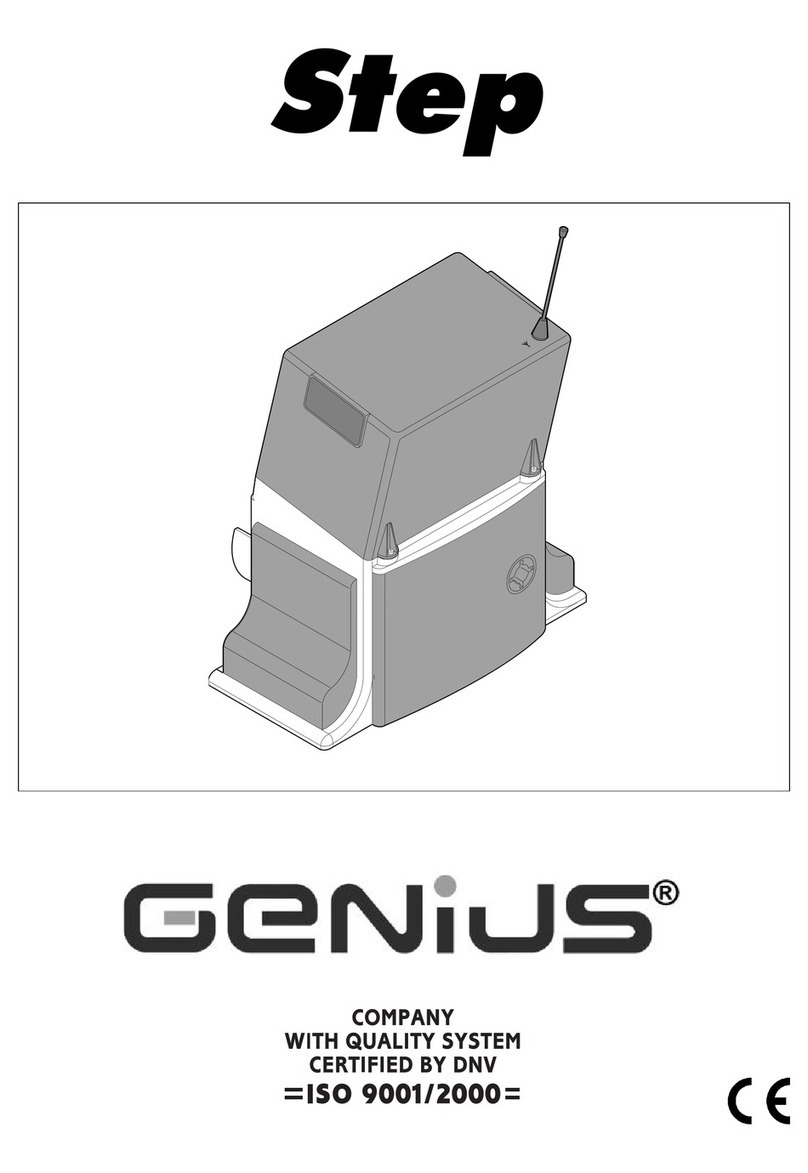
Genius
Genius STEP manual

Wayne-Dalton
Wayne-Dalton 105/110 Installation instructions and owner's manual
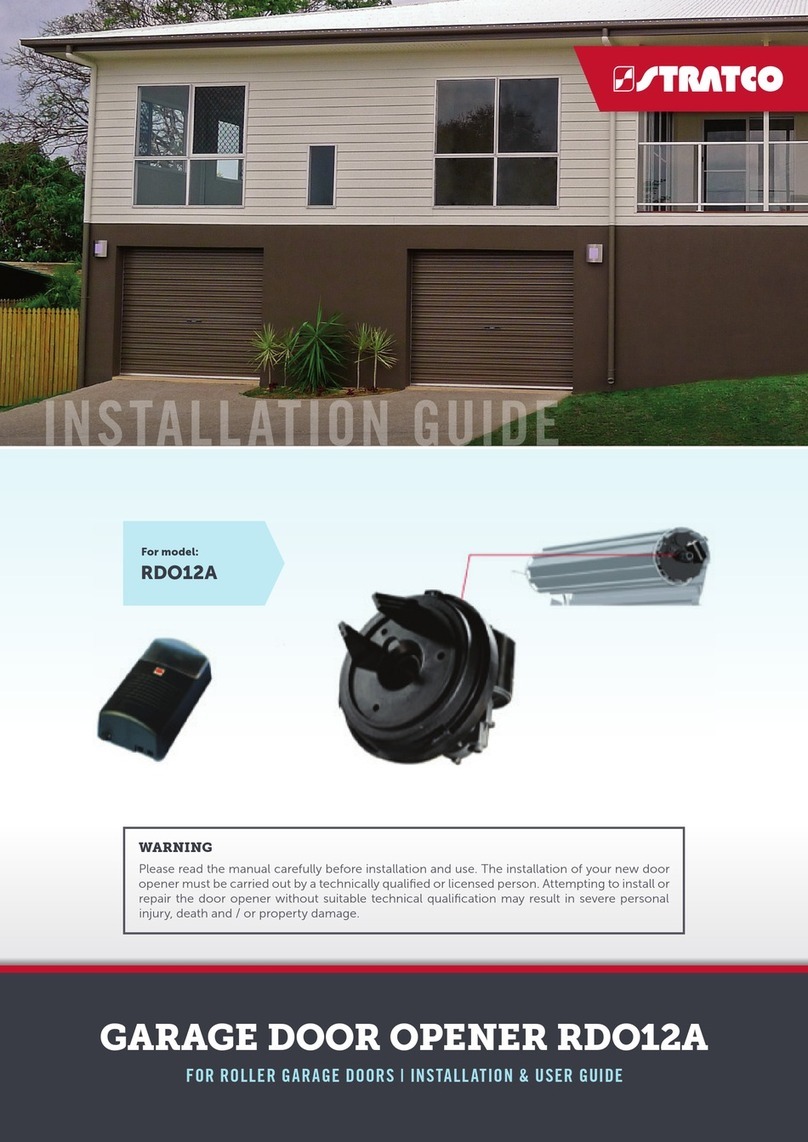
Stratco
Stratco RDO12A installation guide
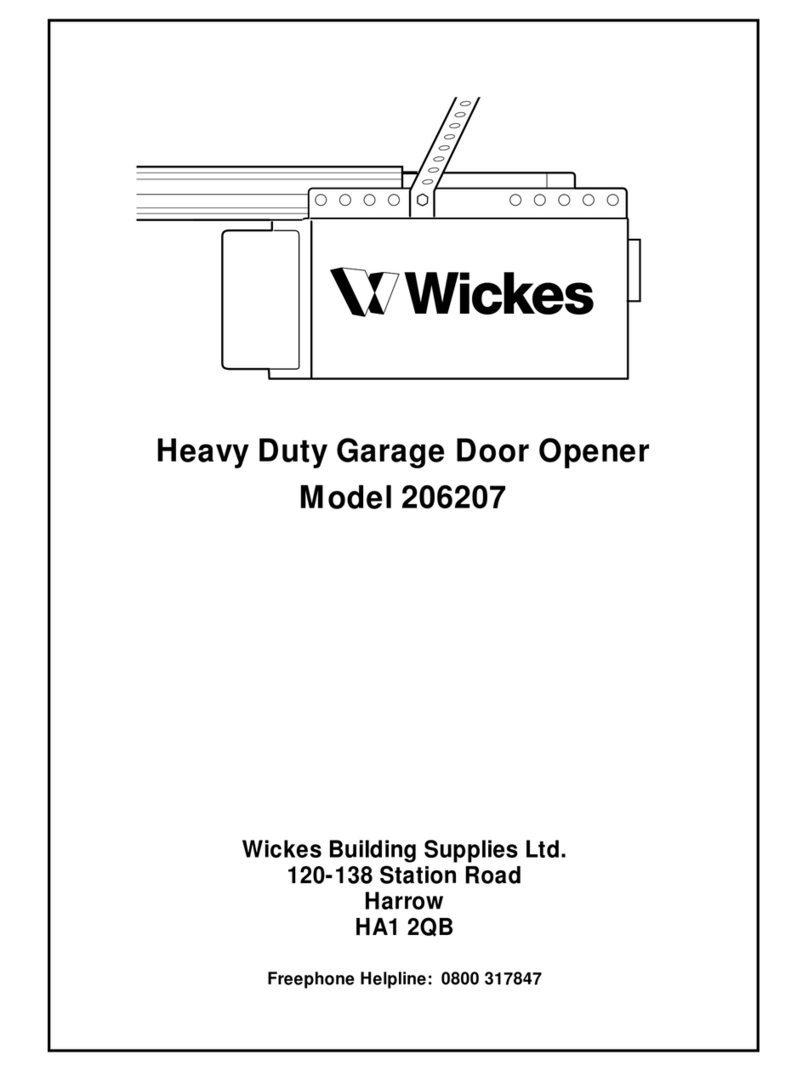
Wickes
Wickes 206207 Installation
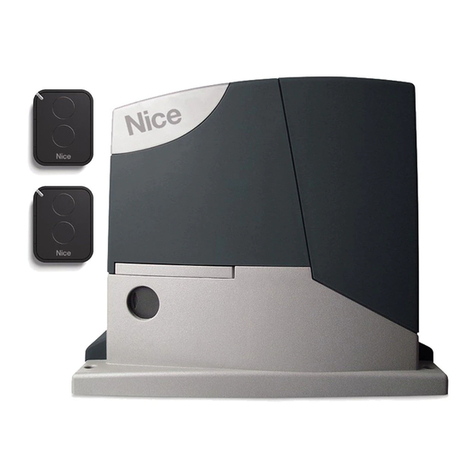
Nice
Nice RD400 Instructions and warnings for installation and use
